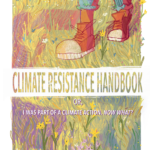A classic problem when talking about climate change? People too often talk about far-away concepts, like polar bears, carbon budget, or images people don’t interact with daily. It doesn’t speak to people’s experiences.
We’ve developed one technique we find helpful in grounding our conversations in how the climate crisis is impacting what’s around us.
Step 1: Start by using examples of climate change around us.
I start talking about climate change by having people look out the window.
Right outside my yard is a tree. Because our spring season came early this year, it bloomed about a month earlier than normal. But that meant it bloomed too early. Frost killed all the buds on the tree. As a result, I can see that the tree outside is weakened.
Or look outside and see the snow. It’s not surprising, since it’s wintertime. But tomorrow, the temperature is supposed to jump up — to way higher than normal. Climate change doesn’t just mean it’s getting hot. It’s often extreme weather changes. So we’re experiencing more dramatic differences.
Or I point out that it’s getting hotter in our summertime. I can see more air conditioners in my neighbors’ windows. We’ve had more hot-temperature summers than ever in our memory.
Step 2. Find out from people what they care about — then link that to climate change.
Ask people what they care about — not related to climate change, but anything. Use that to draw the connection between the thing they care about and climate change.
They care about gardening? Then I talk about how climate change is causing floods and long dry spells and changing the weather patterns. This is stressing native plants and causing many plants to die that previously could be grown in the same place.
They care about football? Then I talk about how even their beloved sport is going to be impacted. More and more games are being played in extreme weather — like the World Cup qualifying match between the United States and Costa Rica being played in freezing cold.
Step 3. Explain the causes and risks to the future
We started with examples of climate change impacts — ones outside our window and ones that our audience cares about. The next step: making the broader general connections. This is where we explain the science of climate change.
We need this step because no individual’s life experiences are sufficient to understand the scope of climate change. It’s a system. That’s why we rely so often on scientists to help us understand what’s happening around the globe.
For example, we might talk about the acceleration of climate change due to feedback loops.
The fact that some trees are dying from climate change in our area is bad. But what worries me and scientists are what we call feedback loops.
You already know that burning carbon dioxide heats up the planet. And the heating of the planet is what’s causing those trees to die.
But what happens when the trees die? They release their trapped carbon dioxide into the atmosphere.
This becomes an accelerating problem. More CO2, more trees dying. More trees dying, more CO2.
It’s the number of feedback loops that causes scientists to point out we’re very close to a tipping point — where the speed of climate changes are unstoppable.
One more example of a feedback loop. You’ve heard about the melting ice on the two poles. Well, it turns out, the problem isn’t just sea level rise.
What happens when you look at snow on a sunny day? It’s bright — the snow reflects the sun’s rays.
On the poles, all that ice does the same thing. It reflects the sun’s rays — reflecting heat away from the earth. But when it falls into the water, the water absorbs the rays.
That means: less ice, more heat absorption on our planet. More heat absorption, faster ice melts.
Feedback loops mean we have to move on this quickly!
Step 4. Offer them a chance to connect to a large movement
We don’t want people to know things. We want them to do things!
So this is where we ask people to join the movement!
What we ask depends on the campaign we’re working on. What do we need right now?
It’s important that any time we talk about climate change, we explain how we can win as part of a social movement. We don’t want to simply depress people. We want to activate them.
None of us as individuals can “save the world.” You each have the piece you can do — and our job as organisers is to help people find the pieces they can do.
So make your pitch to participate in your group!
Get more practice with this method at the “Having Climate Conversations” online skill-up at: trainings.350.org/online-skillups
